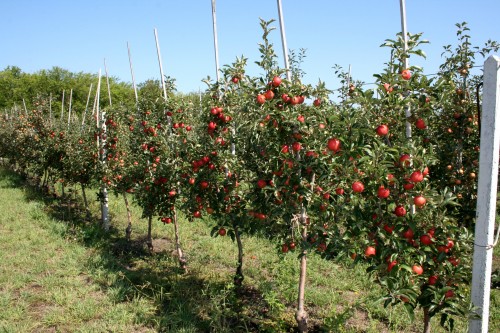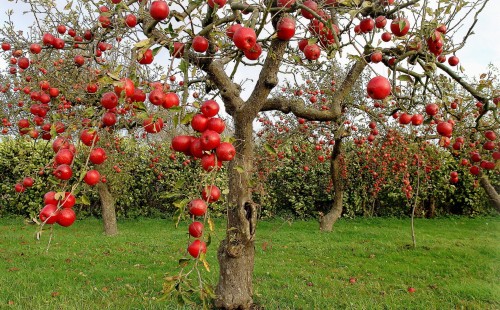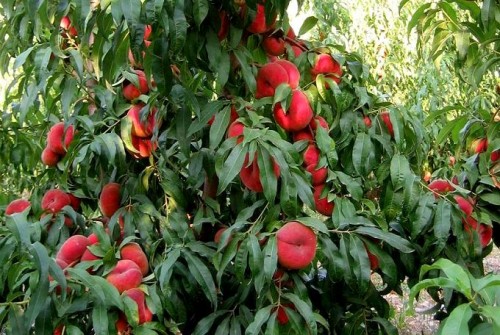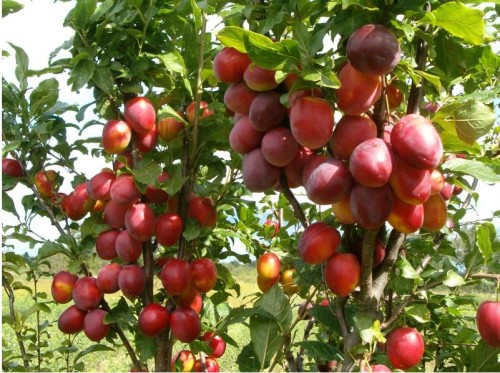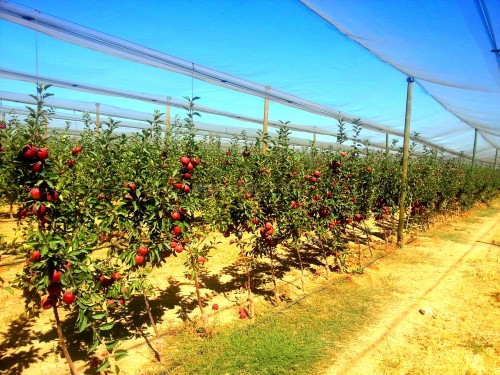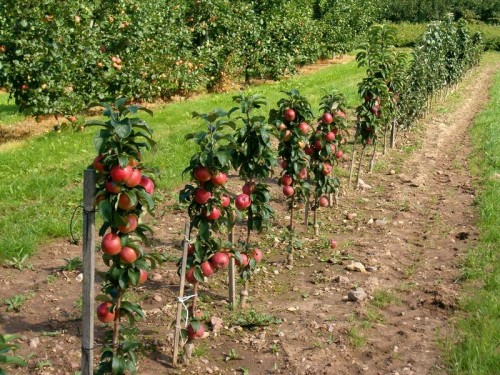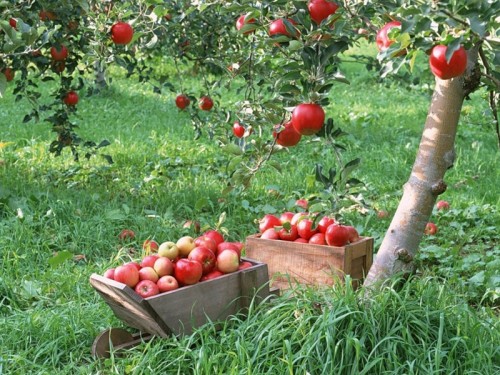Own low -growing garden in the house territory is the dream of many gardeners. Having moved from the farm fields to summer cottages, recently dwarf trees are increasingly widespread among homeowners. The reason for this popularity is a number of advantages, thanks to which vegetation gives the garden a decorative look and provides the owner with a plentiful harvest.
Varieties of trees for a stunted garden
Fruit trees are leaders among all vegetation variations in the dwarf garden. However, not all varieties have their own stunted analogues. A successful solution for modern gardens are peaches, nectarines, apples, pears and plums, since they can be grown even in a pot.
The most common method of growing dwarf trees is to instill them to the usual type of plant. Thus, several small fruit plants can be cultivated at once, which take root well and generously give the crop. However, the stock has its own characteristics, therefore, before buying dwarf trees , you should ask the compatibility of the fruit representative with the plant to which you want to instill culture.
Consider the most popular varieties of stunted trees:
- An apple tree is a variety of a tree to which it is easiest to make a dwarf stock. Modern technologies and experienced breeders have deduced a lot of varieties of dwarf apple trees, which are easy to vaccinate, successfully cope with diseases, and are also extremely fertile.
- Pear - for her it is also quite easy to make a small double. Among all the representatives of the undersized garden, these dwarf fruit trees are abstract by endurance, resistance to weather conditions and give a good harvest.
- Pig Persian varieties Sweet Cap - quite popular seedlings of dwarf trees , which in adulthood do not exceed 1.8 meters of height. This representative is extremely fruitful: the peach has a white pulp of a sweet taste with a small sourness. On such a shaft, a fruit dwarf is characterized by frost resistance, urgency and endurance to drought.
- An increased peach of the UFO variety is the best option for intense plantations. It brings fleshy fruits with yellowish pulp, sugar-sour taste and easily separated by a bone. A dwarf stock for such a peach brings wood resistance to drought, frost, as well as a protective barrier against diseases.
- The dwarf drain of Blue Fri belongs to an early and self -fertile variety. This low -growing representative is resistant to root cancer, drought, frost and chlorosis. The fruits of the tree have an almost black skin with a wax coating, a sweet-acidic taste and oval shape.
- Plum President on Karlikov's stock is the most winter -hardy variety. Such dwarf trees, photos of which are decorated with horticultural publications, give a plentiful crop of excellent quality. The fruits are sweet, have a yellowish-green pulp, without sourness. This variety of dwarf plums quickly fills the garden territory and is very unpretentious in leaving.
- The Chachakskaya drain is a type of late dwarf wood, which gives the crop by the end of September. Plants on such a vain are good at chlorosis and cancer of the root system, and the best pollinators are blonde and walls. The fruits have a yellow-cream pulp, a slightly elongated shape and a sweet-sour taste. The dwarf seeds of the Chachak plums tolerate winter and summer drought.
Advantages of growing a dwarf garden
The low -growing garden has gained wide popularity around the world, thanks to a number of significant advantages. Consider the positive characteristics in detail:
- The early period of fruiting is an important indicator that affects both industrial and individual gardening, since the trees are designed to bring a plentiful crop. Compared to their traditional counterparts, which bear the first fruits only after 4-6 years from the date of planting and require about 10 years to stabilize the crop, dwarf trees are fruitful for 3-4 years. At the same time, the full volume of fruits can be expected after 6-8 years, i.e. The owner reduces the waiting period by an average of 10 years.
- Ease of care. Due to the fact that the height of many representatives of dwarf plantations does not exceed 2 meters, their crown does not grow much and it is much easier to take care of them from a height of human growth. Harvesting, spraying, circumcision of shoots - all these actions are available directly from the ground.
- The small area of \u200b\u200bpower is also a significant indicator for gardeners. In traditional fruit trees, this area can reach up to 42-46 m 2, while dwarf plants require only 7-9 m 2. In other words, on the site where one ordinary tree is grown, you can immediately plant 4-6 stunted analogues.
- High yield indicators are perhaps the main advantage of fruit dwarf seedlings. Breeders, professional gardeners and agronomists confirm that low -growing trees give the best crop than their traditional varieties.
Disadvantages of growing dwarf garden
Despite the impressive advantages of growing trees on Karlikov, a shaft, a stunted garden has its disadvantages. Consider them in more detail:
- considerable starting costs - due to the fact that the creation of a dwarf garden requires more material for planting than the formation of a conventional fruit plantation, initial expenses significantly affect the budget;
- the weakness of some plant species - there are a number of varieties that can be planted only under warm climatic conditions, since they are extremely not winter -resistant;
- low indicators of life expectancy - dwarf trees live much less than tall analogues;
- the risk of loss or change in grade - illiterate planting of trees is fraught with changes in the quality of the variety;
- high expenses for supports - since many types of dwarf trees have a shallow root system, they need to install support pillars. This will avoid damage to the plant with hurricane winds, breaking branches from the crop, soil launders, etc.;
- the need for frequent pruning - for growing dwarf trees, this factor is extremely important, since such manipulations will save the crop from the deterioration of quality, the commodity type of fruits and their grinding;
- the regularity of care - despite the fact that the content of the dwarf garden is a fairly simple business, it requires more frequent care than traditional trees. Otherwise, nature makes its negative adjustments.
Requirements for planting dwarf trees
According to breeders and organic gardeners, annual decorative dwarf trees are best suited for planting the garden . In any case, compliance with the rules of landing will form a fruitful, aesthetic and beautiful garden. Consider the basic requirements for planting plants on a dwarf stock:
- planting occurs in the period of early spring, for which it is necessary to dig a fairly wide and deep hole where you can accommodate the roots of the tree;
- then mix the soil obtained from the pit, adding a little green compost a little;
- cut all the sore tips from the roots of prepared seedlings and dip them in the root mixture;
- food a small amount of compost fertilizer to the bottom of the pit to slightly lift the tree;
- pour a little soil and carefully, shaking the seedling, distribute the soil with your hands between the roots;
- after that, pour the hole with the soil to half of its depth, thoroughly tighten the soil from above;
- pour the rest of the earth outside, compacting it around the tree trunk so that it is stable.
Important! Do not plant a tree too deep to avoid damage, changes in yield and variety.
It is also worth remembering that dwarf trees with a shallow root system must be tied to support. For this purpose, any stand and a strip of rubber is well suited
- tie a rubber harness with a loop around the tree trunk;
- cross it and put on the second loop on the support, slightly higher to make the shape of the eight.
Such a binding holds the seedling well, does not injure its thin bark and does not stretch.
Cultivation of a stunted garden
A plentiful crop, healthy and neat trees is the desire of each gardener. For these purposes, it is necessary to adhere to some requirements for the cultivation of dwarf plantings. Consider them in more detail:
- Thoroughly remove weed plants around the tree, support it clean.
- In order to prevent the formation of crusts on the ground, it must be slightly loosened and used nutritional mulching. As mulch, it is advisable to use compost that decomposed by ½ or ¾.
- For regions with arid weather and rapidly drying soil, the soil needs to be protected and maintained inside valuable moisture. For this, the mouth of hay is suitable.
- Mulch of any type should be at least 60 cm from the barrel of the dwarf seedling at a distance, and the outer border should end with the circumference of the crown of the tree.
- Do not use the mulching technique in especially wet seasons, as well as overly heavy soil.
Fertilizer of dwarf trees
Dwarf trees are perennial stands that develop quite slowly. The growth of new shoots and branches is proportional to the formation of root processes that go into the soil. In order to grow a strong and healthy tree, experienced gardeners use composted manure, decomposed compost mixtures or their combinations.
Such fertilizer must be laid in the soil, but not close to the tree trunk, since this can harm the feeding roots of the plant. Make compost along the diameter of the crown circle, like mulching rules. At the same time, spraying a tree is permissible in the fall and spring, so that it pleases with crop and health.
The setting guide to the stunted garden can be seen on a fragment:

